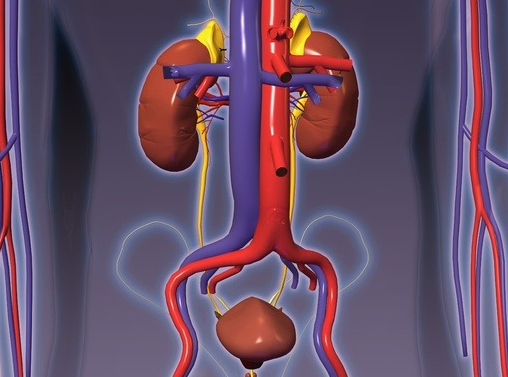So I'd like to --let me start the pulmonary circulation,
我們先介紹一下肺循環(huán)
where you can see that the pulmonary artery and vein --
大家可以分別看到肺動脈和肺靜脈
I'll start that, just to really emphasize the point,
之所以要強(qiáng)調(diào)這里
or actually the reverse of what I've just said, right?
因?yàn)檫@跟我們剛介紹的是相反的
Because the pulmonary artery is actually gonna carry the deoxygenated blood,
大家看肺動脈輸送的是缺氧血
and the pulmonary vein is carrying the oxygenated blood.
而肺靜脈輸送的則是含氧血
So clearly that's the reverse of what I've just said.
很明顯,這跟剛才介紹的是相反的
But that is one exception to the general rule,
這是一個特例
which is that arteries definitely look red, and veins generally look blue.
一般來說動脈是紅色的,靜脈是藍(lán)色的
Okay, so that --those are two points of difference between the arteries and veins.
這是動脈和靜脈之間兩個不同點(diǎn)
Let's keep going.
我們接著看

So now you know, that arteries are high pressure, right?
我們知道,動脈內(nèi)血壓很高
because the heart is pumping the blood out,
因?yàn)樾呐K把血液擠壓輸送出來
and it's gonna be in a very very high pressure.
所以動脈血血壓很高
And so I kind of think of the arteries as being like a river, a fast flowing river.
如果把血管比喻成河流,動脈就是非常湍急的河流
So you can think of this as fast flowing, high pressure.
壓力很大,流速很快
So that is the third difference. This is a high pressure system.
這是它們的第三個不同點(diǎn),動脈中血壓很高
Third difference, it's that it's high pressure system.
動脈的血壓很高
In fact, maybe I'll even emphasize the point by writing the word very large:
為了強(qiáng)調(diào)這點(diǎn),我寫大一點(diǎn)
HIGH PRESSURE.
血壓很高
And actually, the other thing we think about with arteries is that
大家想一下,動脈還有一個特點(diǎn)
there is not so much volume in the arteries.
動脈中血量并不大
So if you actually look at --let's say, froze time now,
假設(shè)我們現(xiàn)在停住時間
you should try to figure out where all the blood was located, not too much of it is in the arteries.
我們來看血液的位置,在動脈中的血液不會太多
So it's actually a very low volume system. I'll write volume very small.
動脈中血量很小
And the veins are the opposite.
靜脈恰恰相反
They're kind of a large volume-- system.
靜脈血量是很大的
And they have really kind of low pressures.
而血壓相對較低
I'll write pressure very small over here.
血壓較低
And if you actually figured out what percent is where, in terms of the amount of blood,
如果要用百分比表示各部位血量的話
about 5% of the blood, at any point of time, would be in the heart.
心臟中大約會有5%的血量
And --let's say, about 5% would be in the capillaries.
5%在毛細(xì)血管中
And then about 10% or so, would be in the lungs.
大約有10%的血存在肺部
So what we have to --now we're 5 and 5 is 10, 10 plus 10 is 20.
5+5=10 10+10=20,已經(jīng)介紹了20%的血量
And then we have another about 15% in the arteries. So about 15%.
大約15%的血量在動脈中
So that's actually not too much blood.
這個血量并不大
And so the remaining --what is that, 65% of the blood, is actually in the vein, at any point of time.
剩下的65%的血液都在靜脈中
So that's remarkable, right?
這個血量是很大的
About two thirds of the blood at any point of time is actually sitting in all the vein combined.
在某時刻,身體的2/3的血液在靜脈中
And so the way I've drawn it, isn't really --not really a best way to draw it.
大家看我畫的圖示,這個不太形象
I should really erase this.
重新畫一下
And really redraw this to make it much more accurate.
如果要對應(yīng)血量來畫的話
It should look a lot more like this, right, like a big giant lake of blood.
應(yīng)該這么畫,靜脈要粗很多
And so this is actually how to think about of the veins.
這是靜脈的特點(diǎn)
It's actually a very very low pressure but high volume system.
血壓低,而血量很大
So that might be the third point.
這是第三個不同點(diǎn)
I'll bring up on the blood side --or, on the vein side.
我寫在靜脈這邊
Is that it's a high volume system. so, high volume.
靜脈血量大



